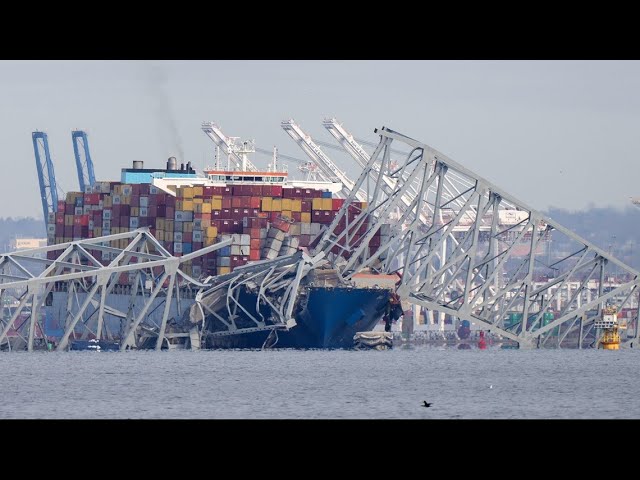The iconic Francis Scott Key Bridge in Baltimore has collapsed as a result of a catastrophic incident involving a cargo ship. But what really happened?
In the dead of night, chaos descended upon Baltimore as a colossal container ship, sailing aimlessly at nine miles per hour, sounded the alarm, hurtling towards the bridge. Departing from the Port of Baltimore merely half an hour earlier, the vessel’s journey turned treacherous as it lost power, careening into a support column with a deafening crash, plunging the vital mid-Atlantic artery into the icy depths below.
Cars were flung into the Patapsco River, and as of Tuesday morning (March 26), six construction workers vanished amidst the wreckage, while two others faced harrowing rescues—one hospitalized, the other refusing aid. A desperate search persisted.
Baltimore awoke to a nightmare: a state of emergency declared by both mayor and governor, a bridge vanished, and frantic search efforts underway. Prior to the calamity, the ship’s crew signaled a distress call, alerting authorities of the power failure. Swift action by the Maryland Transportation Authority Police spared countless lives, halting traffic mere moments before disaster struck.
“These people are heroes,” declared Governor Wes Moore, hailing the swift responders in a Tuesday press conference. He quelled fears of terrorism but also acknowledged the monumental task ahead in rebuilding the bridge, which currently has no certain timeline and cost.
Video footage captured the vessel, shrouded in smoke, colliding with the bridge, triggering a catastrophic collapse. Amidst the chaos, flickering lights signaled impending doom. The Singapore-flagged cargo ship, christened Dali, propelled at 8 knots under local pilotage, as mandated by Maryland law. The pilot faces scrutiny in the aftermath, subjected to drug and alcohol testing. Residents like Priscilla Thompson, jolted from sleep by the cacophony, recounted the terror, likening it to an earthquake.
Clear Video of Traffic movement on Bridge before hit by a ship
— Chaudhary Parvez (@ChaudharyParvez) March 26, 2024
At least 20 vehicles were on the bridge.
#keybridge #baltimore #Ship #FrancisScottKeyBridge #bridgecollapse #USA #BREAKINGNEWS #Baltimore #Maryland #BREAKING pic.twitter.com/NkH36hQ8Qp
With traffic diverted from the 1.6-mile steel giant, part of Interstate 695, a vital artery snaking through Baltimore, disruption looms large. The Port of Baltimore grinds to a halt, with vessel traffic suspended, and the Patapsco River channel blocked—a dire blow to regional commerce.
“We have a long road ahead,” lamented Baltimore County Executive Johnny Olszewski Jr., acknowledging the arduous recovery.
The ship’s origins traced back to Norfolk, Virginia, its departure from Baltimore documented in the early hours. Miraculously, all 22 crew members and two pilots emerged unscathed, a silver lining in the tragedy. The R Adams Cowley Shock Trauma Center bore witness to the aftermath, tending to the injured, one patient already discharged.
Senator Cardin underscored the urgency of search-and-rescue operations, noting the limited number of occupied vehicles on the bridge. Efforts pivoted towards reopening the port, while officials scrambled to contain potential pollution. On the digital frontier, Secretary of Transportation Pete Buttigieg pledged federal support, extending a lifeline to a city grappling with the aftermath of a maritime disaster.
As Baltimore grapples with the fallout, questions linger: What caused the ship’s power failure? Who bears responsibility for this catastrophe? And how will the city rebuild its shattered lifeline?
